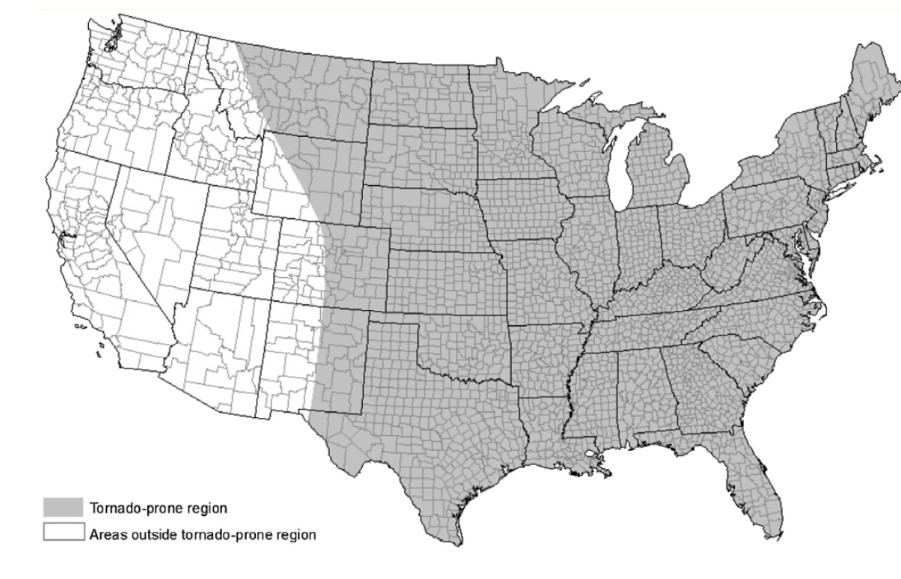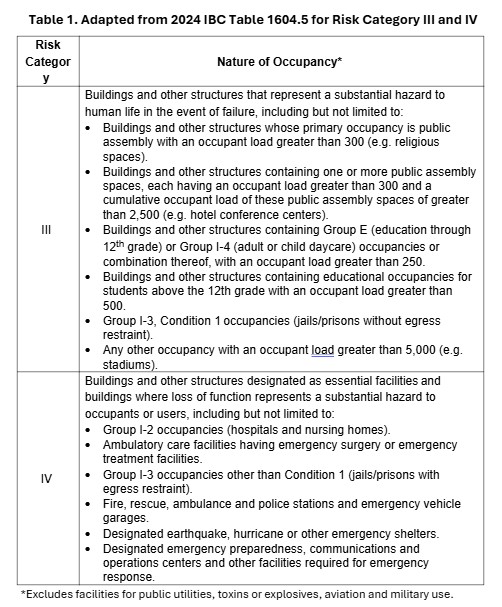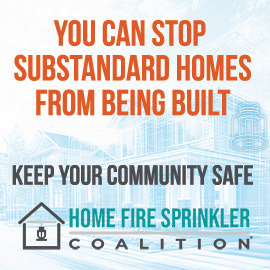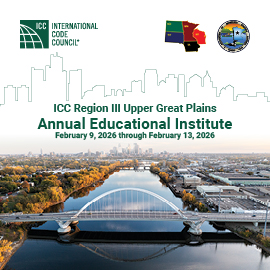
2024 International Building Code Tornado Loads and Community-Based Implementation
This article explores how building safety professionals and the public can enhance building resilience against tornado wind loads.
For the first time in U.S. building code history, the 2024 International Building Code® (IBC) includes tornado wind load design criteria for certain defined areas. With respect to life safety, the inclusion and codification of tornado wind loads in the 2024 IBC may be the most significant change since Hurricane Andrew in 1992. Hurricane Andrew brought focus to extreme hurricane wind loads and subsequent code updates to address high wind structural design.
This article includes a discussion of how community leaders, design professionals, building officials, general contractors and the public may be able to collectively impact building design decisions that can enhance the building resiliency and occupant safety.
According to Showalter and Hyde (STRUCTURE, April 2024), “ASCE 7-22 requirements for tornado loads apply only to Risk Category III and IV buildings sited in the tornado-prone region, which is roughly defined in IBC Figure 1609.5 as the area of the U.S. east of the Continental Divide,” (ASCE 7-22 is part of the 2024 IBC by reference). An example of a Risk Category III building could be “Buildings and other structures containing Group E or Group I-4 occupancies or combination thereof, with an occupant load greater than 250.” The 2024 IBC Figure 1609.5 for the tornado-prone region reflects areas of states subject to tornado activity that may be further refined by the NOAA map for the average annual number of tornadoes per state.

Tornado Outbreak Potential
50 years ago, the Midwest experienced a record tornado event that involved 13 eastern states shown in Figure 2. According to an article published April 3, 2024, by the National Centers for Environmental Information (NCEI):
The human toll of the outbreak can never be fully accounted for, but some statistics related to the outbreak help present an idea of its significance:
- 148 confirmed tornadoes in the U.S. and Canada
- 30 F4 and F5 tornadoes
- The total path length of all tornadoes in the outbreak: 2,598 miles
- 335 direct fatalities
- Over 6,000 injured

More recently, the Joplin, MO tornado on May 22, 2011, was a devastating event, resulting in 161 fatalities and causing nearly $3 billion in damages, according to the National Institute of Standards and Technology (NIST).
When planning for new construction, county, city and regulatory community leaders can benefit by knowing that measures to lessen the community risk exposure due to an extreme wind event are available. Knowing about disaster-related design advancements in the 2024 IBC, leaders and the community can plan based on their analyses of the potential public risk involved and the associated costs for enhanced structural safety.
IBC Adoption by State
The IBC provisions are updated on a three-year cycle by a consensus process that includes tens-of-thousands of experienced building code officials, design professionals, subject matter experts and nation and worldwide researchers. The participants of the consensus process are faced with the challenge of reaching a consensus of what construction provisions and methods are “reasonably safe” for buildings housing single families to the largest structures located in a major city.
The ICC published a table that gives the adoption of International Codes® (I-Codes®) by state that can be viewed here. Many states, known as “home rule states,” have municipalities that adopt and update their codes independently of the state. The table provides an estimate of the maximum number of years before the most recent IBC is adopted by a state (about ten years). The ordinary lag between the IBC edition and state adoption suggests many high occupancy or essential buildings (Category III and IV) will be built and placed in-service without the safety benefits stemming from tornado design load considerations over the next decade.
Risk Categories III and IV Defined
The 2024 IBC defines Risk Categories III and IV in Table 1604.5—Risk Category of Buildings and Other Structures which are summarized in Table 1. Category III and IV buildings are differentiated, respectively, from ordinary buildings and structures (Risk Category II) by:
- “Buildings and other structures that represent a substantial hazard to human life in the event of failure…,” and
- “Buildings and other structures designated as essential facilities and buildings where loss of function represents a substantial hazard to occupants or users…”

The specific IBC edition (2012–2024) adopted by a state or the authority-having-jurisdiction (AHJ) establishes a minimum safety benchmark for all regulated building construction and structures statewide. In some cases, typical building construction deemed to be reasonably safe statewide may not meet the needs and expectations of the local community. For an atypical case, the design professional can design a building “Better Than Code” for any number of reasons such as enhanced wind/tornado protection and other hazards based on life-safety and property concerns.
Leadership Opportunities
Architects can provide critically important leadership in the planning stages of larger occupancy buildings, such as a school or place of worship, by embracing and promoting resilient construction. From the American Institute of Architects (AIA) Climate Action Playbook (2024), “Architects are uniquely positioned to balance the needs of complex systems to create resilient buildings and communities; prioritize issues to guide decision-making; protect health, safety, and welfare; and communicate a vision of the future with creativity and innovation.” As such, their participation and leadership can be a reminder for elected officials and boards that occupant safety should be paramount in the decision-making process.
How does the inclusion of tornado design requirements in the 2024 IBC relate to leadership opportunities for engineers? For discussion purposes, the objectives of the IBC requirements and provisions are twofold:
- Protect the health, safety and welfare (HSW) of the public, and
- Protect all aspects of property, function and building safety
Regarding the first objective, engineers have a unique role to “…first and foremost, protect the health, safety, and welfare of the public” (American Society of Civil Engineers (ASCE) Code of Ethics, 2020). The National Society of Professional Engineers (NSPE) and other engineering professions mirror the ASCE language and priority. In addition to the public safety mission, engineers may be knowledgeable of and understand the importance of new life-safety design provisions in the most recent 2024 IBC edition, such as tornado design provision for larger occupancy and/or Risk Category III and IV buildings.
In the context of planning a new elementary school, a local or regional engineer has an opportunity to provide leadership in the community by communicating the potential benefits of requiring a tornado wind design per the 2024 IBC. Community input by an engineer could be pivotable for the structural wind design, reducing the code adoption gap (typically three to ten years).
The Building Official (or representative from the jurisdiction) could provide leadership as a planning committee member and provide input on the policy for updating to the 2024 IBC and its tornado design provisions. Elected officials, boards and project planners may not know that tornado wind design options exist and that the jurisdiction would likely approve the IBC design requirements for a Risk Category III and IV project.
A local General Contractor could provide leadership by serving on a planning committee and responding to construction-related questions. For example, two relevant questions might be:
- Would securing the materials and construction needed for improved wind resistance be an obstacle for a general contractor?
- If after construction and in-service the community wanted to upgrade the school to be more resistant in the event of a tornado, how difficult would you expect it to be?
Small–Town One–School Example
For many reasons, a small community may have additional safety concerns for a specific construction and occupancy that may be atypical when compared to a larger community that would typically have multiple schools for similar grade groups. For an atypical case, a design professional could design “Better Than Code” for any number of reasons such as enhanced wind/tornado protection and other hazards potentially impacting life-safety. An atypical case might be as follows:
- Midwest rural town
- New Pre-K to 2nd Grade school building to replace old school
- New school to accommodate 200 students
- One single-story building, open space
- State has adopted the 2015 IBC
A new school designed to resist tornado load parameters could mitigate damage and potentially save the lives of children. Based on 2024 IBC Table 1604.5, the new school would not meet the conditions for Risk Category III (Group E… with an occupant load greater than 250). To some extent, the example is an anomaly and points to the potential value of a community evaluating and making risk-based decisions based on regional tornado history, life–safety concerns and potential for a community disaster.
For the case of planning a new elementary school in Category III in a jurisdiction that has not yet adopted the 2024 IBC, local governing officials and boards are generally the decision makers and thus, could greatly benefit by engineering and building code related input. Professional design in early planning stages could result in several desired outcomes:
- A construction that is more resilient by requiring tornado design provisions per the 2024 IBC
- Minimal additional construction costs
- Lower insurance premiums
Cautionary Note
The implementation of the 2024 IBC Chapter 16 tornado design provisions does not yield a structure that qualifies as a “storm shelter” or “safe room.” According to a 2023 FEMA/NIST Design Guide:
Storm shelters and safe rooms are specifically designed for life safety protection during the most extreme wind events and require more extreme design hazard intensities than conventional buildings. Buildings and other structures designed per Chapter 32 of ASCE 7 do not meet the requirements for storm shelters or safe rooms. Storm shelters and safe rooms must adhere to the ICC 500, Standard for the Design and Construction of Storm Shelters (ICC/NSSA, 2020) specifications, and/or FEMA P-361, Safe Rooms for Tornadoes and Hurricanes: Guidance for Community and Residential Safe Rooms (FEMA, 2021), respectively.
Wind design speed requirements for a storm shelter or safe room are substantially greater than for a building construction that is designed for enhanced tornado protection per Chapter 16 of the 2024 IBC. Storm shelters are designed to save lives, no matter how large the tornado is. For example, the storm shelter design wind speed in the central U.S. is 250 mph. This design wind speed is much greater than the 2024 IBC tornado wind speeds for buildings of approximately 80-125 mph for Risk Category III and 95-140 mph for Risk Category IV.
Conclusions
In communities located in a Tornado-Prone Region that have not yet adopted the 2024 IBC, local government officials, new construction boards, planning committees and the public could benefit from the leadership and expertise of local construction professionals during the early planning stages of a new building. Background and public discussion of tornado event history, basic wind design principles and factors, the current building code edition and design wind speed for the location, as well as updated wind design provisions in the most recent building code, can help build strong public support for more resilient construction. Such support can lead to improvements that enhance the health, safety and welfare of occupants in regions vulnerable to tornadoes. ‘
For a typical or atypical case wherein the community has reason(s) to believe their risk exposure is elevated, local government officials, boards and building community planners will make their own risk assessments as to what level of protection might be desired and justified for specific construction. Design professionals (architects and engineers) could evaluate the building as a Risk Category III or IV to assist decision-makers and prepare construction documents that require additional (or Better Than Code) measures to guard against a community tragedy.






